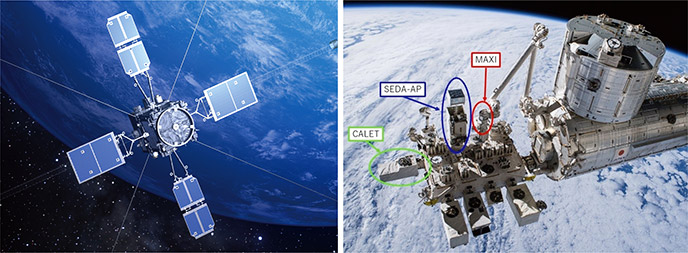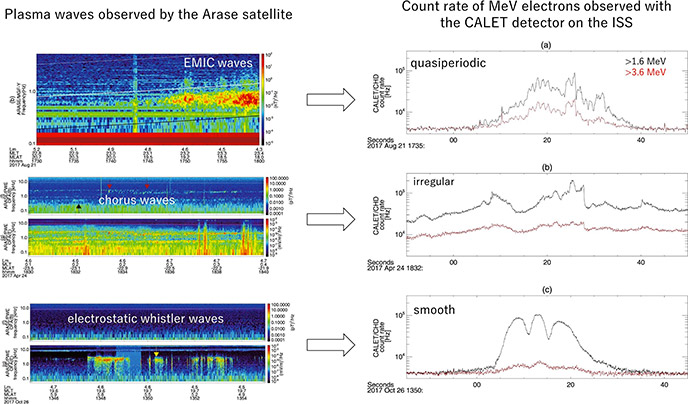National Institute of Polar Research
On the trail of causes of radiation events during space flight
Lessons from conjunction observations with ISS detectors and the Arase satellite.
Released on September 4, 2020 (in Japanese)
Posted on October 5, 2020
Scientists have made significant progress in understanding the sources of radiation events that could impact human space-flight operations. Relativistic Electron Precipitation (REP) events are instances when high energy electrons move through areas of space at significant fractions of the speed of light. These REP events may pose challenges to human spaceflight, specifically during extravehicular activity (EVA).
These hazards motivate the question of whether REP events can be forecasted in order to avoid unnecessary human exposure to radiation. In order to predict REP events, their cause must first be determined.
A scientific team led by researchers at the National Institute of Polar Research (NIPR) in Japan has made strides in answering that question. Their findings were published on August 14 in the Journal of Geophysical Research: Space Physics.
Ryuho Kataoka, the lead author of the study and an associate professor at NIPR, pinpointed the cause of REP events and emphasized that REP events must be accounted for in human spaceflight missions.
“The importance of understanding REP events has been increasing since the REP events have been clearly identified at International Space Station (ISS),” Kataoka said. “REP events are important because they cause radiation dose during EVAs.”
It has been hypothesized that electromagnetic ion cyclotron (EMIC) waves play an important role in REP events at the ISS. It was still an open question, however, whether other mechanisms played a role in REP event generation. EMIC waves are electromagnetic waves that propagate through the plasma in Earth’s magnetosphere, causing disturbances in the charged particles within the plasma.

Figure1: Left: the Arase satellite. Right: Three different detectors on the ISS were complementarily used. SEDA-AP (Space Environment Data Acquisition equipment-Attached Payload), CALET (Calorimetric Electron Telescope), and MAXI (Monitor of All-sky X-ray Image). Credit Left: ©ERG science team. Right: ©JAXA/NASA.
Using multiple sensors aboard the ISS, as well as data from the Arase satellite, the research group was able to show that at least three separate processes contributed to REP events. One is indeed EMIC waves. But the data also suggested two other sources: Whistler mode chorus waves and electrostatic whistler waves. Whistler mode waves can be excited by high energy electrons associated with auroral activities, such as the Northern Lights.
Figure2: Plasma waves observed by the Arase satellite (left) and count rate of MeV electrons observed with the CALET detector on the ISS (right).
“It turned out that REP events at the ISS are caused not only by EMIC waves but also by whistler mode waves, which makes the space weather forecast more difficult,” Kataoka said.
With a better understanding of the physical causes of REP events, Kataoka and his team are working towards ways to predict future events. “The next step is the space weather forecast of REP events at the ISS by modeling different kinds of plasma wave activities. The ultimate goal is to obtain a unified theory to understand the interaction between energetic particles and plasma waves, and their impact of radiation dose on the atmosphere, space craft, and human beings.”
Original article:
Journal: Journal of Geophysical Research: Space Physics
Title: Plasma Waves Causing Relativistic Electron Precipitation Events at International Space Station: Lessons From Conjunction Observations With Arase Satellite
Authors:
Ryuho Kataoka (NIPR, Japan / SOKENDAI, Japan)
Yoichi Asaoka (Waseda University, Japan)
Shoji Torii (Waseda University, Japan)
Satoshi Nakahira (Japan Aerospace Exploration Agency, Japan)
Haruka Ueno (Japan Aerospace Exploration Agency, Japan)
Shoko Miyake (National Institute of Technology (KOSEN), Ibaraki College, Japan)
Yoshizumi Miyoshi (Nagoya University, Japan)
Satoshi Kurita (Nagoya University, Japan / Kyoto University, Japan)
Masafumi Shoji (Nagoya University, Japan)
Yoshiya Kasahara (Kanazawa University, Japan)
Mitsunori Ozaki (Kanazawa University, Japan)
Shoya Matsuda (Japan Aerospace Exploration Agency, Japan)
Ayako Matsuoka (Japan Aerospace Exploration Agency, Japan / Kyoto University, Japan)
Yasumasa Kasaba (Tohoku University, Japan)
Iku Shinohara (Japan Aerospace Exploration Agency, Japan)
Keisuke Hosokawa (The University of Electro-Communications, Japan)
Herbert Akihito Uchida (SOKENDAI, Japan)
Kiyoka Murase (SOKENDAI, Japan)
Yoshimasa Tanaka (NIPR, Japan / SOKENDAI, Japan / Joint Support-Center for Data Science Research, Japan)
DOI: 10.1029/2020JA027875
URL: https://agupubs.onlinelibrary.wiley.com/doi/10.1029/2020JA027875
First Published: August 14, 2020
Funding:
R. K. is supported by JSPS KAKENHI 15H05815, 16H06286, 17K05671. R. K. and Y. A. are supported by JSPS KAKENHI 17H02901. Y. M. is supported by JSPS KAKENHI 15H05815, 15H05747, 16H06286, 17H00728, and 20H01959. S. T. is supported by JSPS KAKENHI 19H05608.









